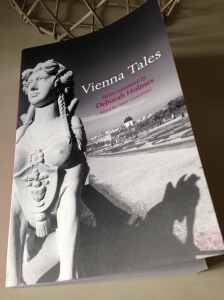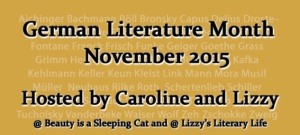I’ve long wanted to visit Vienna – a European city break is just my type of holiday. I’m sure I’ll get there one day, but in meantime, what better way to experience the city than through its literature.
Vienna Tales is a collection of stories featuring Vienna. This diverse anthology includes pieces by older, established writers such as Arthur Schnitzler (1862-1931), Joseph Roth (1894-1939) and Adalbert Stifter (1805-68), along with works by more contemporary authors, many of whom were new to me. As with other collections I’ve reviewed, I’m not going to try to cover each story in turn. My aim instead is to give a flavour of the themes and a little of what I thought of the anthology as a whole.
The stories in Vienna Tales are arranged geographically rather than chronologically, so we roam around the capital from west to east and back again. Several of the pieces are set in the margins of Vienna, reflecting the centre from a distance, but each one seems to capture a different facet of the city.
The collection opens with The Four-poster Bed, a poignant story about the demise of a love affair. In this early work by Arthur Schnitzler, a melancholy summer evening reflects the dying embers of one man’s love for a ‘sweet, darling girl’:
The last embers of sunset died down. Cool shadows crept up the houses, slowly, until they disappeared on the roofs. All that remained, way out on the last buildings, was a reddish, aching glow. (pg 24)
Many of the stories are packed with imagery, pictures of life in Vienna in the 19th and 20th centuries. In one of my favourite pieces from the collection, The Prater by Adalbert Stifter, we follow the narrator on an afternoon walk through this extensive park, an area that combines parkland, meadows, a fairground, beer stalls, coffee houses and more remote woodlands. It’s a feast day in May, and the Prater is bustling with activity:
Carriages drive through the midst of this crowd like ships in pack-ice, mostly slowly, often held up and forced to stand still for many minutes at a time, but then, when gaps present themselves, flying past each other like gleaming phantoms through the stolid, meandering mass. Figures on horseback can be seen rearing up out of the sea of pedestrians here and there, hopping over and through the line of carriages; (pgs. 164-165)
Joseph Roth’s short sketches, Day Out and Merry-go-round, also fall into this category.
Another of my favourites is The Feuilletonists by Ferdinand Kürnberger (1821-79), a delightfully amusing piece in which the narrator describes the characteristics of each type of feuilletonist (writers of feuilletons) to be found in the city. (Originating in France and Germany, popular in the mid-19th century, a feuilleton was the part of a newspaper or journal devoted to fiction, cultural criticism, light literature and gossip.) In Kürnberger’s sketch, we are introduced to the house feuilletonist, a writer who draws on his domestic surroundings for inspiration. Then we have the street feuilletonist, aka ‘the flaneur’ in high German, or ‘loafer’ in low German:
Exemplars of this species can often be found in front of the window displays of the larger fancy goods and fashion emporia. They also loiter in doorways to let the architecture of the magnificent new buildings opposite “work” on them; unfortunately, prestigious edifices freshly built in Vienna cannot be enjoyed from any other point of view. (pg 108)
By contrast, the tavern feuilletonist is to be found in the coffee houses of Vienna. ‘You will never find it there with a newspaper, but always with cards or a billiards cue in its hand. Loathing for periodical publications of all kinds is a distinguishing characteristic of this kind of journalist.’ There are one or two others as well, but I’ll let you discover them for yourselves should you decide to read this book. (Incidentally, a Viennese coffeehouse, Konditorei Demel, also features in Anton Kuh’s Lenin and Demel, a short piece on deposed aristocrats trying to getting to grips with the new culture following WW1.)
Several of the pieces in this anthology touch on the mood or atmosphere of the city. In Vienna by Heinrich Laube (1806-84), a man is entering the capital from the south by horse-drawn carriage. As he travels towards his inn in the dawn light, the visitor reflects on his impressions of Vienna.
Although I hadn’t even arrived at my inn, I could already tell how I would fare there. The city’s aspect is not one of overwhelming beauty, but picturesque, charming mellow. The warmer skies, the lilting speech, the plump, succulent bodies of the Viennese, their customs and habits, everything is locked in so blissful an embrace that the impulse is to open one’s own arms wide. And in Vienna, no one opens them in vain. It is a supremely humane and accommodating place. (pg. 97)
By contrast, we see a different perspective on the city in Dimitré Dinev’s excellent story, Spas Sleeps. This contemporary piece features Spas, a Bulgarian refugee who fled to Vienna at the end of the 20th century in search of a new beginning. At the start of the story, Spas is sleeping on the street, but the vast majority of this tale focuses on the years leading up to this point. Reflecting on the time of his arrival in Vienna in the 1990s, Spas was full of hope and ambition, full of belief in the future. He longed to find work as it represented everything: a means of survival, peace of mind and the only way of staying in the city.
Work was a spectre. It hid itself from them and tormented everyone. Only those who found it found peace of mind. Six months should be long enough, the law decreed. After that it persecuted anyone who still haunted the place without work: an exorcist who thought six months was long enough to prove who is a person and who is a ghost. The ideal world wished to remain so. (pgs. 133-134)
We follow Spas and his friend, fellow Bulgarian student, Ilija, as they search for any kind of work, be it temporary manual jobs or something more stable. The two young men share everything, pooling their resources along with the opportunities to work and study. As the years pass, the laws get tighter and tighter making it increasingly hard for them to survive. There are many compromises and sacrifices along the way. This is a very poignant, thought-provoking story, one that remains all too relevant in Europe today. I think it will stay with me for a long time.
There are stories by other contemporary writers too. These include: Envy by Eva Menasse (b. 1970) – a subtle story that touches on love, loss and the tensions in a family; and Six-nine-six-six-nine-nine by Doron Rabinovici (b. 1961) – an eerie story of a composer who, when he rents a garret in the Viennese suburbs, hears a mysterious voice on the phone line.
Vienna Tales is a really interesting collection, all the more so for the sheer variety of pieces included. I would recommend it to any lover of literature with an interest in the city. The anthology also contains an excellent introduction by the curator, short biographies of each writer and a myriad of suggestions for further reading on Vienna (both fiction and non-fiction).
I’ll finish with a favourite quote from Out for a Walk by Schnitzler, in which four men debate their differing perspectives on the city. For one man Vienna is a melancholy place, for another it has a strong sense of nostalgia, for the third man it is merry and carefree while the fourth feels it has let him down. As the story opens, the sun is setting, and the men are walking to the periphery of the city:
Grimy children played noisily in the streets; and on the dull green meadows that began here and faded into gentle hill country further out, there were common folk who yearned for fresher air without knowing it: little boys and girls rolling on the ground or running to and fro, soldiers smoking cheap cigars with idiotically cheerful off-duty faces, streetwalkers in twos and threes laughing loudly as they strode over the fields, and the occasional solitary wanderer who had ventured out to savour the atmosphere of this peculiar no-man’s land where the city gradually comes to an end, its raw, drawn-out, fearful panting ceasing in a weary, thankful sigh. (pgs. 259-260)
Emma and Marina Sofia have also reviewed this collection, which I read for Caroline and Lizzy’s German Literature Month.
Vienna Tales is published in the UK by Oxford University Press. Source: review copy kindly provided by the publishers.


